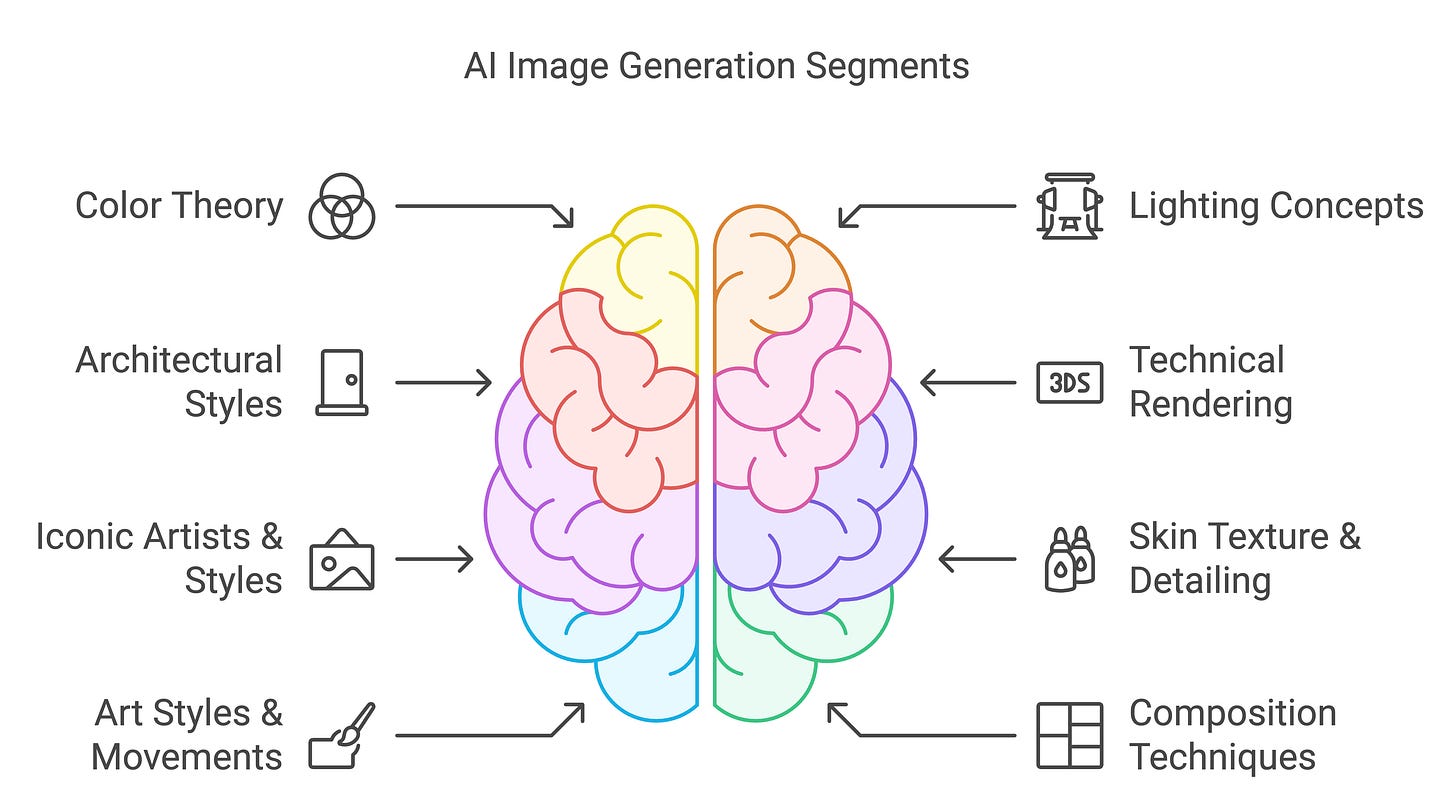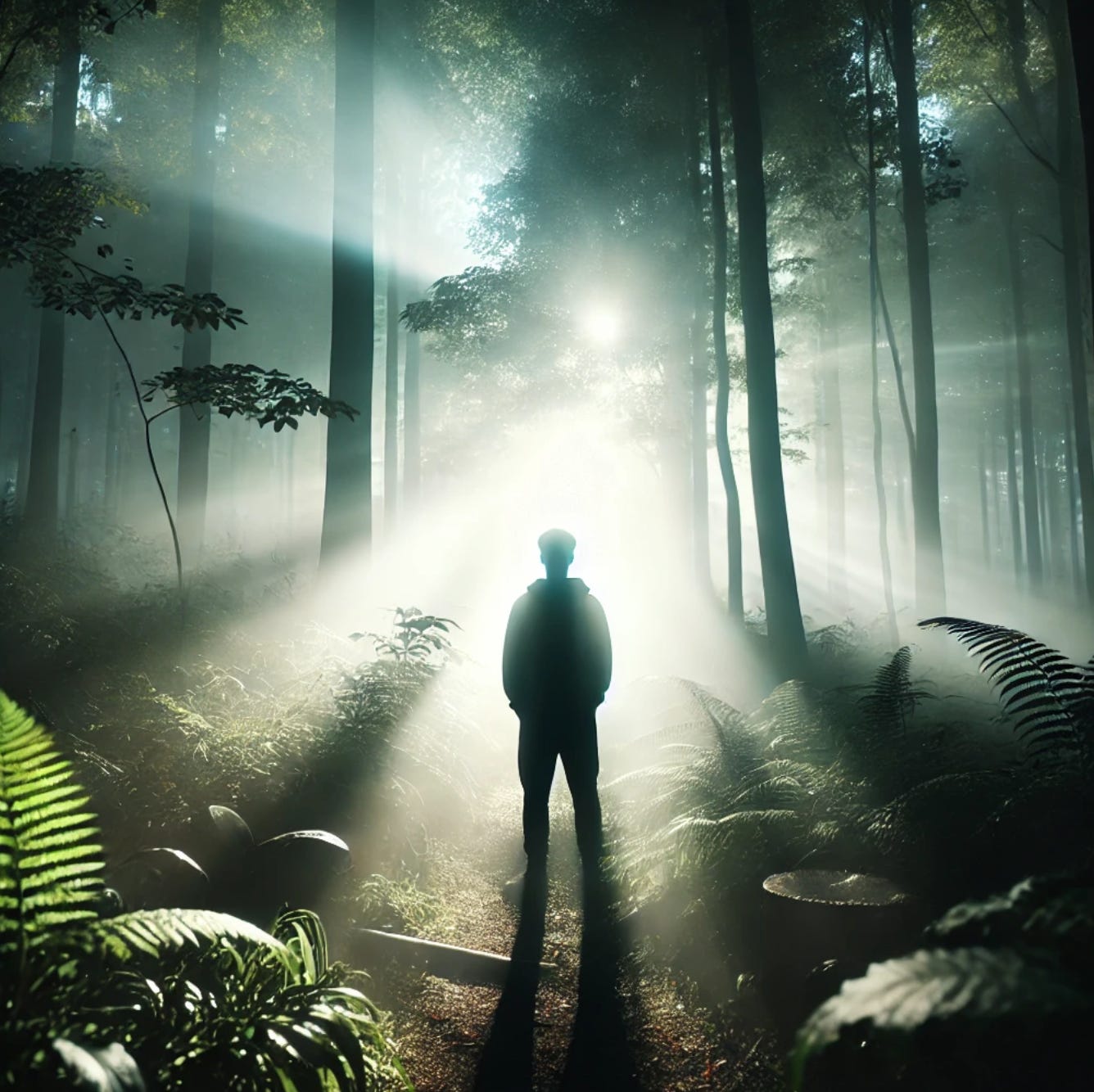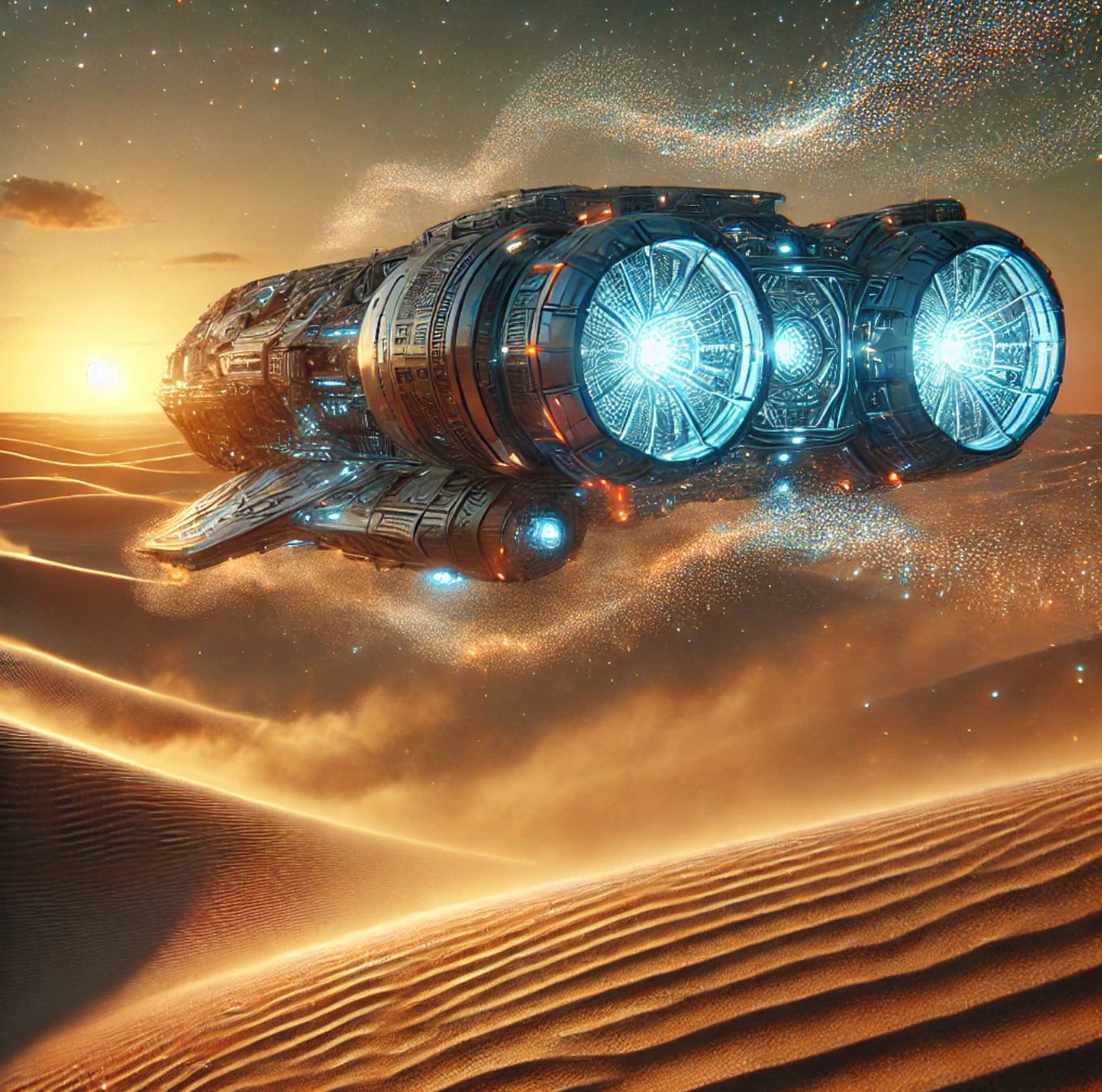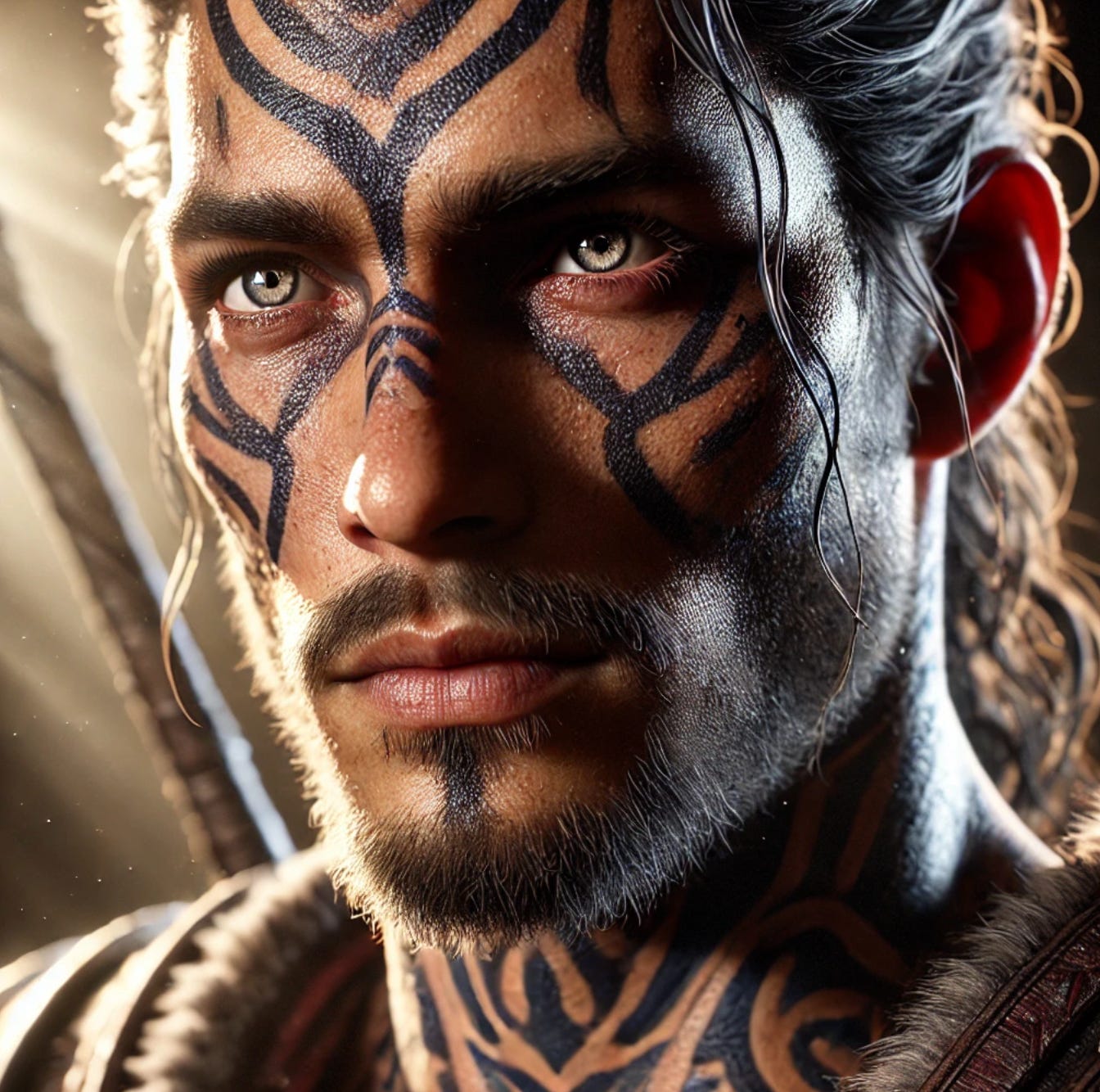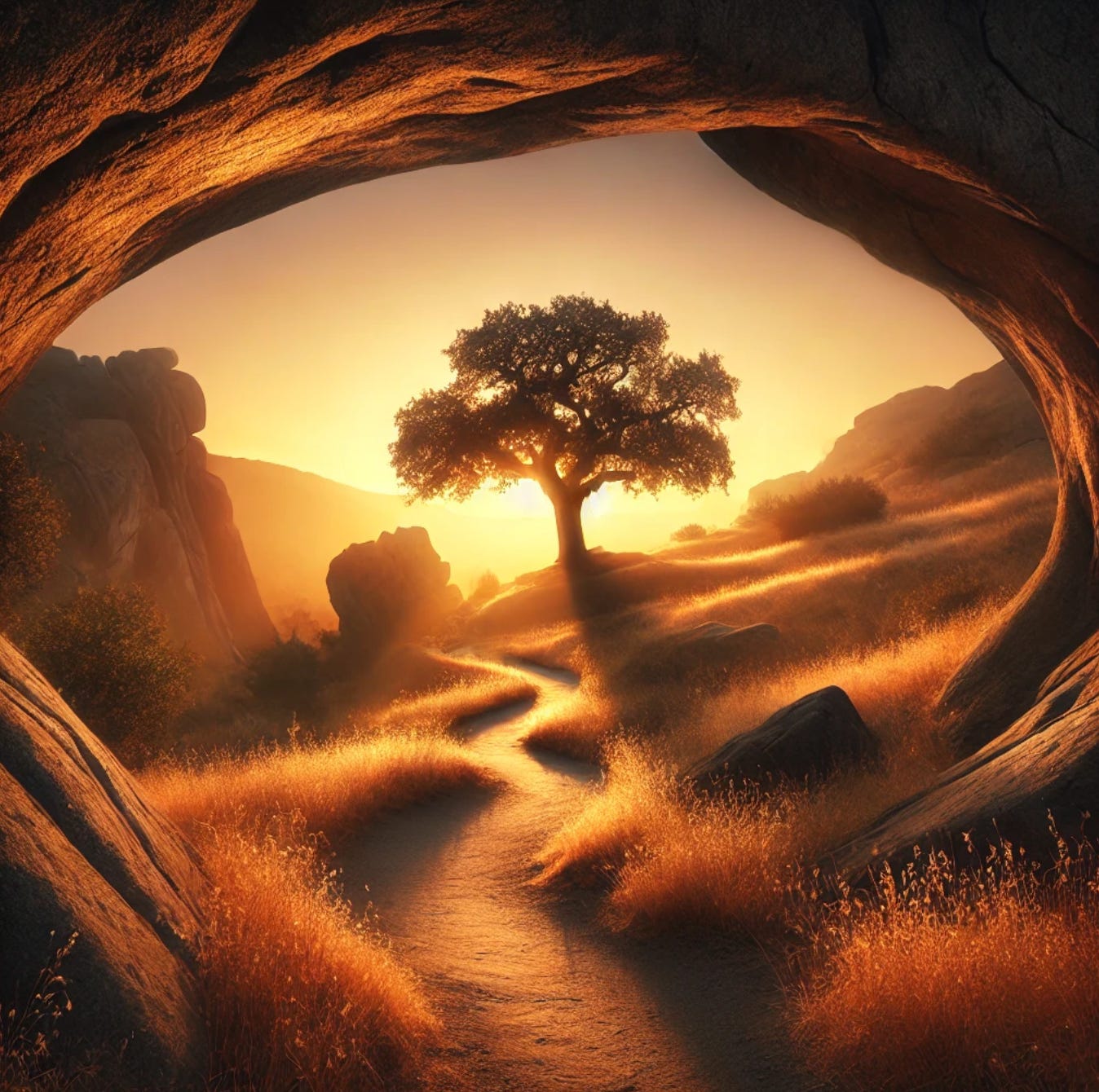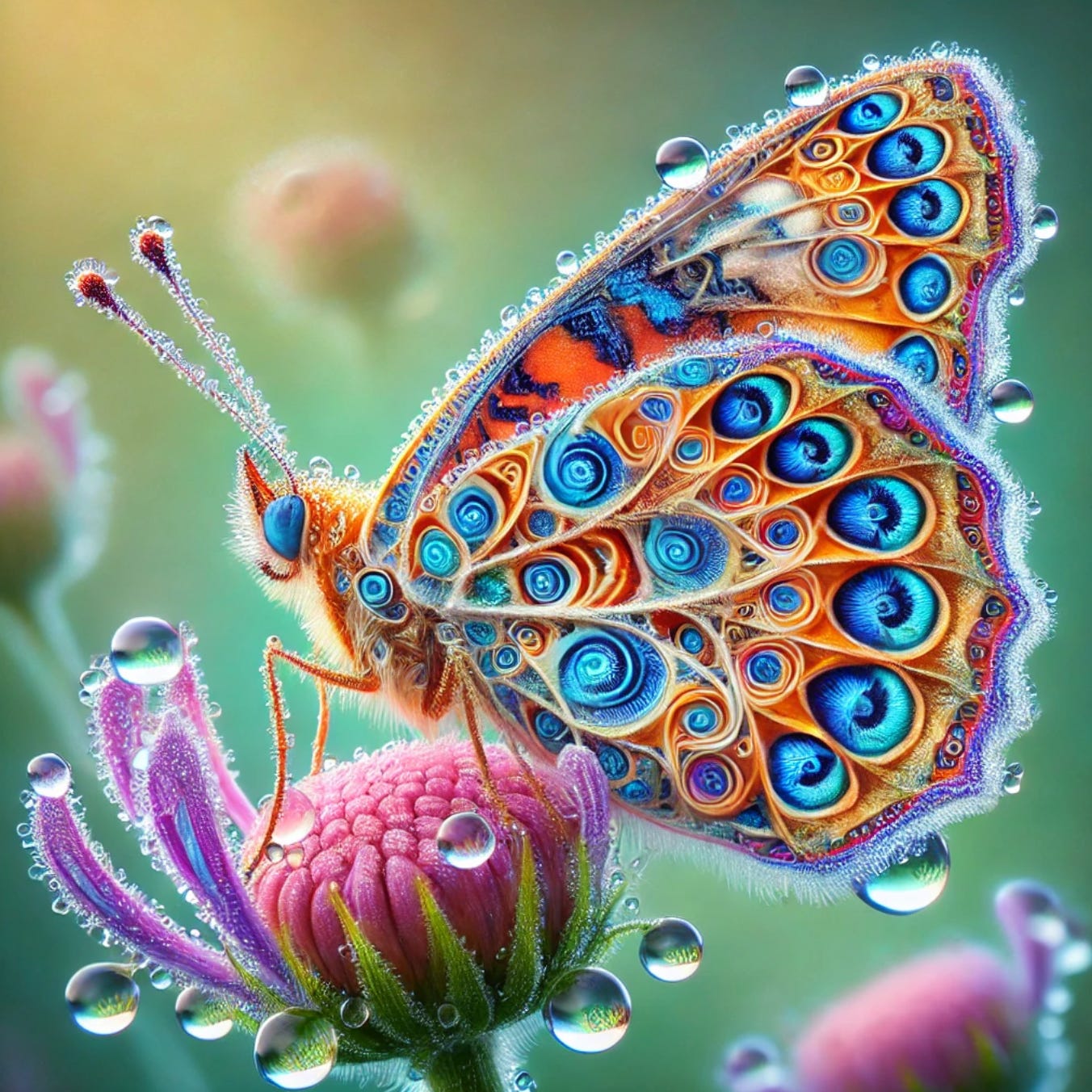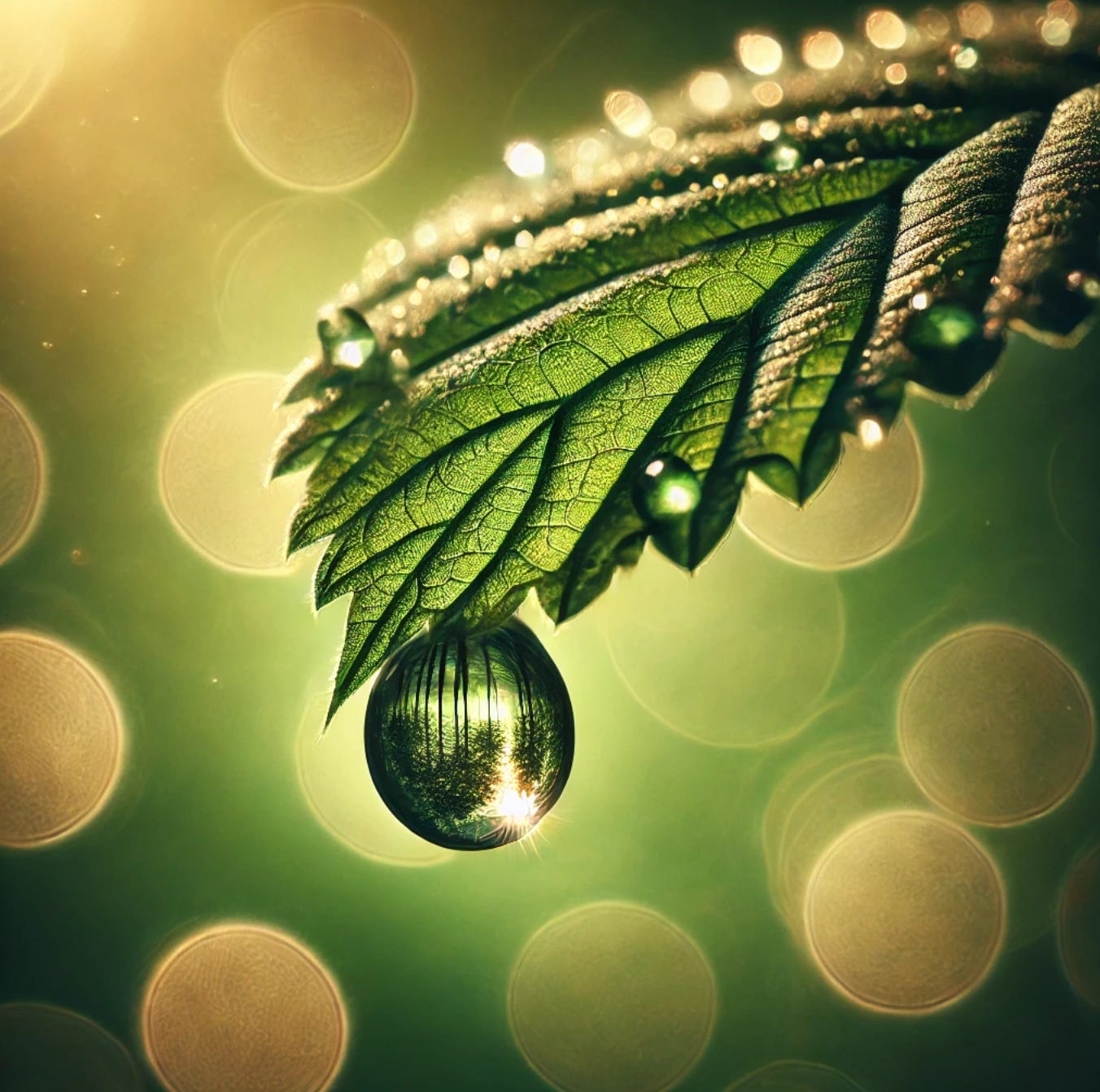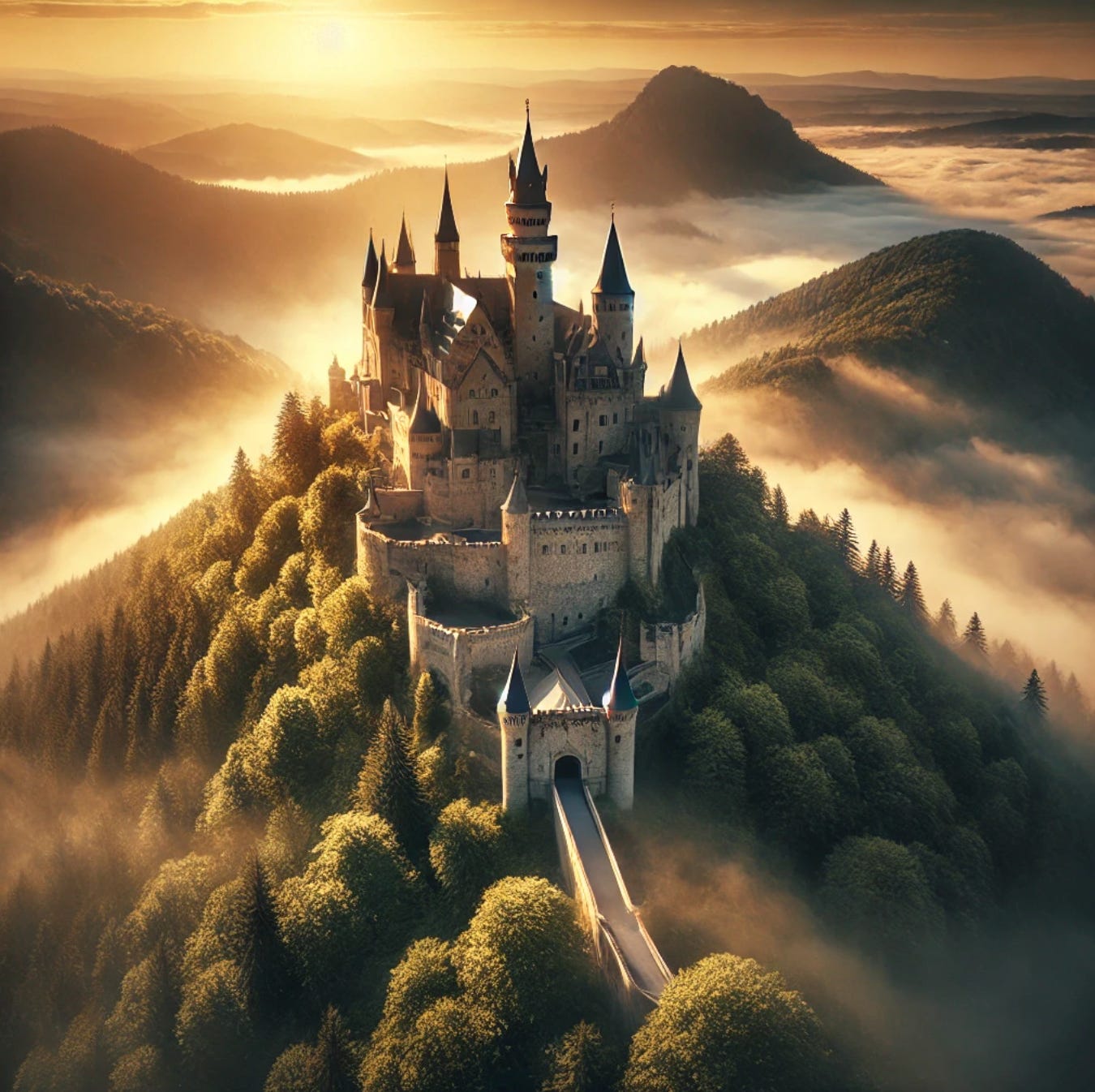The Ultimate Midjourney Guide
Well not just Midjourney, but any AI image generation tool I'd say. Since it is more about art & photography rather than sole prompting.
I've been experimenting with AI tools for quite some time now and have noticed something intriguing. While framing your prompts effectively in ChatGPT can lead to better text outputs, AI image generation tools like Midjourney/Dall-E require an extra ingredient to truly shine.
The Secret Sauce: Technical Precision
Beyond just framing the idea, these prompts need to be technically detailed in describing the image you envision. Do you want it rendered as a watercolor painting or a hyper-realistic photograph? Should the camera angle be a bird's-eye view or a low-angle shot? What about the lighting—soft and diffused or sharp and dramatic?
When it comes to creating images, the level of detail you provide increases exponentially. This is why individuals with a solid understanding of art and photography often produce far superior images compared to those who don't. They know how to communicate the nuances that bring an image to life.
The quality of these AI-generated images has direct implications for their use cases—be it in advertising creatives, custom packaging designs, or digital art. High-quality, well-crafted visuals can make a significant difference in capturing attention and conveying your message effectively.
Note - Due to email length constraints, I couldn't include sample images for every chapter, but I’ve added as much as possible to spark your creativity. For the rest, I encourage you to experiment with generating them yourself—it’ll be a fun and rewarding process!
So, without further ado, let's dive into the chapters that will help you harness the full potential of AI image generation tools.
Chapter 1: Color Theory
Understanding color theory is essential for creating visually appealing images. Colors can set the mood, draw attention, and convey emotions. Here are key concepts:
Primary Colors: Red, blue, and yellow are the primary colors from which all other colors can be mixed. Often used to create bold, striking visuals. In design, primary colors can make elements pop.
Secondary Colors: Green, orange, and purple, created by mixing primary colors. Used to expand the palette and add complexity to designs.
Complementary Colors: Colors opposite each other on the color wheel (e.g., red and green). Create high contrast and vibrant looks, often used to make subjects stand out.
Analogous Colors: Colors that are next to each other on the color wheel (e.g., blue, blue-green, and green). Produce harmonious and soothing visuals, ideal for backgrounds and landscapes.
Monochromatic Schemes: Variations in lightness and saturation of a single color. Creates a cohesive and elegant look, often used in minimalist designs.
Triadic Colors: Three colors evenly spaced around the color wheel (e.g., red, yellow, blue). Offers a balanced yet vibrant palette, good for dynamic and lively compositions.
Sample Prompt: "A vibrant abstract artwork featuring complementary colors of deep blue and bright orange, blending seamlessly with a gradient of analogous shades like teal and turquoise. The design is accentuated with soft monochromatic elements in varying shades of blue for balance, creating a harmonious yet striking composition."
Chapter 2: Lighting Concepts
Lighting dramatically affects the mood and perception of an image. It highlights textures, creates depth, and sets the overall atmosphere.
Natural Lighting: Utilizes sunlight or moonlight to create realism and depth. Often used in outdoor photography and landscapes.
Artificial Lighting: Includes man-made sources like lamps or LEDs for precise control. Common in studio settings.
Backlighting: Light placed behind the subject, creating silhouettes or dramatic halos. Used for moody or mysterious images.
Rembrandt Lighting: Creates a triangle of light on the shadowed cheek of a subject. Adds drama and depth, often used in portrait photography.
High-Key Lighting: Bright, even lighting with minimal shadows. Evokes an upbeat or clean mood, frequently seen in fashion or product photography.
Low-Key Lighting: Predominantly dark tones with focused highlights. Conveys mystery, suspense, or a cinematic feel.
Sample Prompt: "A cinematic portrait of a figure standing in a misty forest, illuminated by soft backlighting that creates a glowing halo effect. The scene features high-key natural lighting to highlight the vibrant greens of the forest and contrasting low-key shadows for depth and mystery."
Chapter 3: Architectural Styles
Different architectural styles set the tone, evoke specific historical periods, or add a thematic backdrop.
Gothic Architecture: Features pointed arches, ribbed vaults, and ornate details. Evokes medieval or fantastical atmospheres.
Modernism: Focuses on simplicity and functionality with clean lines and minimal ornamentation. Represents contemporary aesthetics.
Baroque Style: Known for grand, elaborate designs and dramatic use of light. Conveys opulence and dynamic movement.
Brutalism: Characterized by raw concrete and massive forms. Creates a stark, imposing aesthetic.
Art Deco: Combines geometric shapes and rich decoration. Reflects the glamour and sophistication of the 1920s and 1930s.
Futurism: Emphasizes dynamic forms and advanced technology. Ideal for sci-fi or avant-garde designs.
Sample Prompt: "A surreal cityscape combining Gothic cathedrals and futuristic skyscrapers, illuminated by glowing neon lights. The design merges the intricacy of Gothic arches with the clean, angular lines of modernism, creating a striking visual contrast."
Chapter 4: Technical Rendering
Rendering techniques define the visual style of an image, from abstract sketches to photorealistic detail.
Wireframe Models: Basic 3D structures represented by lines and vertices. Often used for technical drafts or preliminary designs.
Photorealistic Rendering: Creates images indistinguishable from real photos. Common in product visualization and architecture.
Sketch Rendering: Mimics hand-drawn illustrations with visible strokes. Used for concept art and early-stage ideas.
Isometric Rendering: Displays 3D objects in 2D without perspective distortion. Ideal for technical drawings and video games.
Cel Shading: Uses flat colors and bold outlines to create a cartoon-like effect. Popular in animation and stylized graphics.
Particle Effects: Simulates natural phenomena like smoke, fire, or magic. Enhances fantasy or sci-fi visuals.
Sample Prompt: "A photorealistic rendering of a futuristic spacecraft hovering above a desert, surrounded by glowing particle effects simulating sandstorms. The design includes intricate wireframe structures visible through semi-transparent panels, blending realism with technical precision."
Chapter 5: Iconic Artists & Styles
Incorporating elements from iconic artists adds a unique aesthetic and cultural depth to your images.
Pablo Picasso (Cubism): Breaks subjects into geometric shapes for abstract compositions.
Vincent van Gogh (Post-Impressionism): Bold, swirling brushstrokes with vibrant colors. Conveys emotion and movement.
Salvador Dalí (Surrealism): Dreamlike, bizarre imagery with a focus on detail.
Andy Warhol (Pop Art): Bold, repetitive imagery inspired by consumer culture.
Frida Kahlo (Symbolism): Personal, vibrant, and deeply emotional art.
Hokusai (Japanese Woodblock): Clean lines and flat colors, often depicting nature and landscapes.
Sample Prompt: "A surreal portrait in the style of Salvador Dalí, featuring a melting clock as the subject’s face. The background swirls with vibrant colors reminiscent of van Gogh, with geometric shapes inspired by Picasso framing the scene."
Chapter 6: Skin Texture & Detailing
Skin texture adds realism or stylization to portraits and character designs.
Smooth Skin: Flawless and polished, commonly used in beauty and fashion photography.
Textured Skin: Shows pores, wrinkles, and imperfections for realism and character depth.
Freckles and Moles: Adds individuality and natural beauty.
Scars and Markings: Tells stories or adds emotional weight to characters.
Tattoos and Body Art: Expresses cultural identity or personal style.
Unique Skin Conditions: Albino skin or vitiligo creates striking and memorable visuals.
Sample Prompt: "A hyper-realistic portrait of a warrior with textured, scarred skin, adorned with intricate tribal tattoos. The lighting emphasizes every detail, with freckles and faint battle marks adding to the character's depth."
Chapter 7: Art Styles & Movements
Art styles influence the mood and structure of your visuals.
Impressionism: Loose brushstrokes that capture light and movement, ideal for serene landscapes.
Surrealism: Dreamlike scenes blending reality and fantasy.
Expressionism: Distorts reality to convey strong emotions.
Abstract Art: Focuses on shapes, colors, and patterns without depicting specific subjects.
Minimalism: Strips designs to their essence, focusing on simplicity and space.
Pop Art: Bold, colorful imagery inspired by popular culture.
Sample Prompt: "An abstract artwork inspired by Expressionism, using vibrant, distorted shapes to depict an emotional outburst. Splashes of color blend into surreal dreamlike patterns, evoking a sense of chaos and beauty."
Chapter 8: Composition Techniques
Composition organizes elements within the frame to guide the viewer’s eye.
Rule of Thirds: Divides the frame into thirds for balanced placement of subjects.
Leading Lines: Draws the viewer’s focus through the image.
Framing Elements: Uses natural or artificial elements to frame the subject.
Symmetry and Asymmetry: Symmetry creates harmony, while asymmetry adds interest.
Depth of Field: Isolates the subject with a blurred background or integrates it with a sharp one.
Negative Space: Highlights the subject by surrounding it with emptiness.
Sample Prompt: "A tranquil image of a lone tree at sunset, framed by the natural arch of a rock formation. The leading lines of a winding path guide the viewer's eye to the tree, with a blurred background emphasizing its solitude."
Chapter 9: Weather & Environments
Weather conditions set the mood and context of a scene.
Sunny Skies: Bright lighting conveys optimism and energy.
Rainy Scenes: Muted tones and wet surfaces add melancholy or freshness.
Snowy Landscapes: Evokes purity, isolation, or adventure.
Foggy Atmospheres: Creates mystery and softness.
Stormy Weather: Adds drama and tension with dark clouds and lightning.
Desert Scenes: Represents endurance or exploration.
Sample Prompt: "A cinematic view of a lone traveler in a desert, with a sandstorm brewing in the distance. The muted tones of the landscape contrast with the glowing warmth of the setting sun breaking through the storm."
Chapter 10: Fashion, Clothing & Textiles
Fashion elements reflect character, setting, or culture.
Haute Couture: Luxurious, custom-made designs for high-end elegance.
Streetwear: Casual, urban styles associated with youth and rebellion.
Traditional Attire: Cultural garments like saris, kimonos, or kilts add authenticity.
Futuristic Fashion: Sleek, innovative designs suited to sci-fi themes.
Vintage Styles: Nostalgic looks from specific historical eras.
Sustainable Materials: Reflect eco-consciousness and natural aesthetics.
Sample Prompt: "A futuristic fashion shoot featuring models in glowing metallic outfits inspired by haute couture, set against the backdrop of a neon-lit cyberpunk cityscape."
Chapter 11: Biological & Natural Elements
Nature introduces life and movement to visuals.
Flora: Trees, flowers, and plants add vibrancy and symbolism.
Fauna: Animals bring dynamism and storytelling.
Microbiology: Cells and microorganisms create intricate, abstract patterns.
Human Anatomy: Adds realism to character designs.
Ecosystems: Depict forests, oceans, or deserts to set a natural scene.
Geological Forms: Rocks and mountains symbolize stability and endurance.
Sample Prompt: "A macro shot of a vibrant butterfly perched on a dew-laden flower, with the intricate patterns on its wings mirroring fractal designs found in microbiology."
Chapter 12: Emotional Tone & Atmosphere
Emotion transforms a visual from static to impactful.
Joyful: Bright colors and dynamic scenes convey happiness.
Melancholic: Muted tones and reflective expressions evoke sadness.
Mysterious: Shadows and obscured elements create intrigue.
Energetic: Bold movements and vibrant hues suggest action.
Tranquil: Soft lighting and calm compositions promote peace.
Tense: High contrast and tight framing heighten suspense.
Sample Prompt: "A tranquil lakeside scene at sunrise, with soft pink and blue hues in the sky reflected in the still water, evoking peace and serenity."
Chapter 13: Camera Techniques & Settings
Camera techniques add depth and creativity to your image.
Long Exposure: Blurs motion for dreamy effects like light trails or smooth water.
Macro Photography: Extreme close-ups reveal unseen details.
Tilt-Shift: Creates a miniature effect by blurring edges selectively.
Panoramic Views: Expansive shots capture wide scenes.
Slow Motion: Highlights the beauty of movement.
Bokeh Effect: Produces aesthetic blur in out-of-focus areas.
Sample Prompt: "A macro photograph of a raindrop hanging from a leaf, reflecting an upside-down forest, with a bokeh background of soft green and golden lights."
Chapter 14: Abstract Concepts & Symbolism
Abstract ideas add layers of meaning to visuals.
Time: Represented by clocks or decaying objects to symbolize transience.
Freedom: Birds in flight or open spaces evoke liberation.
Conflict: Clashing colors or fractured objects suggest struggle.
Growth: Budding plants or ascending shapes symbolize progress.
Duality: Mirrors or yin-yang motifs explore contrasts.
Transformation: Butterflies or metamorphosis signify change.
Sample Prompt: "A surreal image of a cracked hourglass leaking sand that turns into birds mid-flight, symbolizing the fleeting nature of time and freedom."
Chapter 15: Time Periods & Cultural Contexts
Historical or futuristic settings anchor visuals in specific contexts.
Renaissance: Classical, detailed themes emphasizing humanism.
Victorian Era: Ornate, formal designs reflecting 19th-century elegance.
Ancient Egypt: Symbolism with pyramids and hieroglyphs.
Futuristic Settings: Advanced technology and space exploration.
Medieval Times: Castles, knights, and folklore-rich themes.
Roaring Twenties: Jazz-age glamour with bold, geometric designs.
Sample Prompt: "A futuristic metropolis with glowing towers and hover cars, blending Art Deco shapes from the 1920s with sleek sci-fi elements."
Chapter 16: Human Anatomy & Facial Features
Anatomy impacts realism and style in character design.
Proportions: Accurate sizing for realism.
Expressions: Faces conveying specific emotions enhance storytelling.
Gestures: Body language adds dynamics.
Diversity: Reflects a range of ethnicities, ages, and appearances.
Aging: Wrinkles or youthful features depict life stages.
Stylized Features: Exaggerated traits for cartoon or fantasy aesthetics.
Sample Prompt: "A portrait of an elderly man with deep wrinkles and a wise, thoughtful gaze, rendered in hyper-realistic detail with dramatic side lighting to emphasize his features."
Chapter 17: Design Textures, Patterns & Materials
Textures and patterns enrich the tactile quality of visuals.
Wood: Natural warmth and organic grain patterns.
Metal: Shiny, reflective surfaces suggest strength or modernity.
Fabric: Silk, denim, or leather adds realism.
Geometric Patterns: Modern, repetitive shapes like triangles or hexagons.
Organic Patterns: Flowing, natural forms like waves or spirals.
Glass: Transparency and reflections create elegance.
Sample Prompt: "A modern coffee table made of polished wood with intricate geometric inlays, resting on a reflective glass floor in a sleek, minimalistic room."
Chapter 18: Perspective, Depth & Spatial Relations
Perspective adds realism and guides the viewer's eye.
One-Point Perspective: All lines converge to a single vanishing point for depth.
Aerial Perspective: Distant objects appear lighter and less detailed.
Foreshortening: Compression of objects viewed at an angle adds drama.
Overlapping Elements: Indicates spatial relationships and layers.
Scale and Proportion: Emphasizes size differences to suggest distance.
Isometric Perspective: Maintains equal dimensions along.
Sample Prompt: "A majestic medieval castle perched atop a steep mountain, viewed from a low-angle perspective to emphasize its grandeur. The scene incorporates overlapping layers of mist-covered trees in the foreground, with the castle fading into aerial perspective in the distance, surrounded by a golden sunrise that highlights the scale and depth of the composition."
Conclusion
Whether you're exploring color theory, lighting, or abstract concepts, each chapter of this guide equips you with tools to transform your ideas into stunning visuals. Remember, the magic lies in the details—every nuance you include in your prompts shapes the final output.
If you’d like to connect further, I’m here to help. I offer mentorship for individuals looking to refine their skills, navigate career decisions, or simply brainstorm fresh ideas.
Thank you for taking the time to explore this guide. I look forward to bringing the next edition soon.
Best Regards,
Ayush



